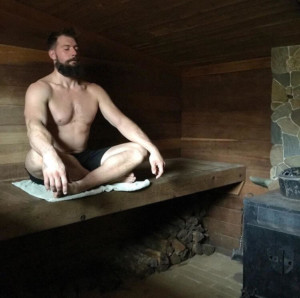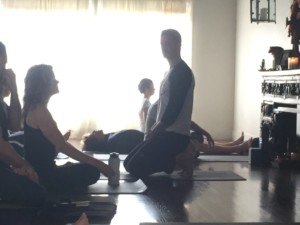By Rob Wilson
 In so many languages the word for spirit, breath and life are synonymous. Is this merely a fun coincidence or is there a deeper understanding of this profound connection that humans have had for a long time? Developing even a basic understanding of the breath connects to our deeper physiology in a profound and meaningful that would be hard to overstate.
In so many languages the word for spirit, breath and life are synonymous. Is this merely a fun coincidence or is there a deeper understanding of this profound connection that humans have had for a long time? Developing even a basic understanding of the breath connects to our deeper physiology in a profound and meaningful that would be hard to overstate.
While our ancestors may not have had the scientific jargon available to describe the physiological components of breathing they nevertheless had millennia of experiential data and encoded the importance of this subtle and powerful awareness into words, some of which are words used in common vernacular and in esoteric disciplines as well.
These similarities in prescribing a singular word to describe these phenomena, across what are in every other way very different human cultures, speaks to the fundamental keystone that breath represents in the human experience. While some of the verbiage from ancient esoteric disciplines is lost on our modern ears where we often prefer scientific nomenclature over more poetic descriptions, it’s important to not lose sight of the simple fact that hidden in these words is a deep human connection to the breath.
Qi/Chi (Chinese), Ki (Japanese/Korean), Prana (Sanskrit), Spiritus (Latin), Dukh (Russian), Anda (old Norse), and Neshumah (Hebrew) are just a handful of examples of ancient words meaning not only subtle energy as the Eastern traditions often use them, but are also synonymous with breath and the force of life itself. In Hawaii, the term for foreigner, ha’ole, literally means without breath. As the Hawaiians observed that the early Europeans who arrived on the islands breathed inattentively during prayer and thus had no spirit. Whether or not you buy into this romantic notion one thing is for sure; the ancients had a deeper appreciation for breathing than most of us in today’s modern climate.
 Breathing is something we mostly take for granted. On average humans take 23,040 breaths per day, 8,409,600 breaths per year, and a whopping 600+ million breaths in a lifetime. Breathing is the fundamental life-giving force in our bodies. We can go weeks without food, days without water, but only minutes without air. Yet, of all the nutrients it gets the least credence. We are paying attention to how we move, how we eat, and our hydration (fanatically so at times in sport and fitness), but we give breathing a miniscule amount of psychological energy. We take it almost wholly for granted. Until it’s gone that is. If you’ve ever choked (or been choked), spent time pinned under water, or just trained to your full cardiorespiratory capacity you have come face to face with just how important air is. Unfortunately, human beings are often short sighted. When the emergency lights go off we forget all about it and resume our normal behavior.
Breathing is something we mostly take for granted. On average humans take 23,040 breaths per day, 8,409,600 breaths per year, and a whopping 600+ million breaths in a lifetime. Breathing is the fundamental life-giving force in our bodies. We can go weeks without food, days without water, but only minutes without air. Yet, of all the nutrients it gets the least credence. We are paying attention to how we move, how we eat, and our hydration (fanatically so at times in sport and fitness), but we give breathing a miniscule amount of psychological energy. We take it almost wholly for granted. Until it’s gone that is. If you’ve ever choked (or been choked), spent time pinned under water, or just trained to your full cardiorespiratory capacity you have come face to face with just how important air is. Unfortunately, human beings are often short sighted. When the emergency lights go off we forget all about it and resume our normal behavior.
It doesn’t have to be this way. Just as we can bring awareness into any other aspect of our lives, taking on a breathing practice is just as much about controlling our minds and being centered in the present moment as it is about having greater dominion over our biochemistry. In fact one could argue that these are two descriptions for the same phenomena. Maybe the ancients had more right than we give them credit for? An interesting example of this is how the cadence breath of apnea training 1:4:2 (inhale:hold:exhale) is the same instruction given to yogis to raise energy* in their bodies and ultimately control subconscious physiological processes (read autonomic nervous system). This same pattern of using the breath to control the body/mind continuum is seen in spiritual practices the world over and is found in warrior disciplines both feudal (samurai “hara”) and modern (marksmanship involves breath hold on trigger pull). These all boil down to the fundamental concepts of and therefore extend a more powerful influence into the world in which we live. Whether this is through sports performance, combat, or just in relationships with our fellow human beings.
 Archaic terms such as Ki, prana, and the like are just symbolic representations of the ideas that breath, energy, and life are tied together in an unbreakable way that penetrates deep into what it means to be a human being. These words are symbols that express root ideas so that we can communicate more clearly with one another and remind us of the fundamental importance that this understated aspect of our physiology holds. Knowing this is the first step to knowing yourself through breath.
Archaic terms such as Ki, prana, and the like are just symbolic representations of the ideas that breath, energy, and life are tied together in an unbreakable way that penetrates deep into what it means to be a human being. These words are symbols that express root ideas so that we can communicate more clearly with one another and remind us of the fundamental importance that this understated aspect of our physiology holds. Knowing this is the first step to knowing yourself through breath.
*Kundalini, The Arousal of the Inner Energy, Ajit Moorkerjee
